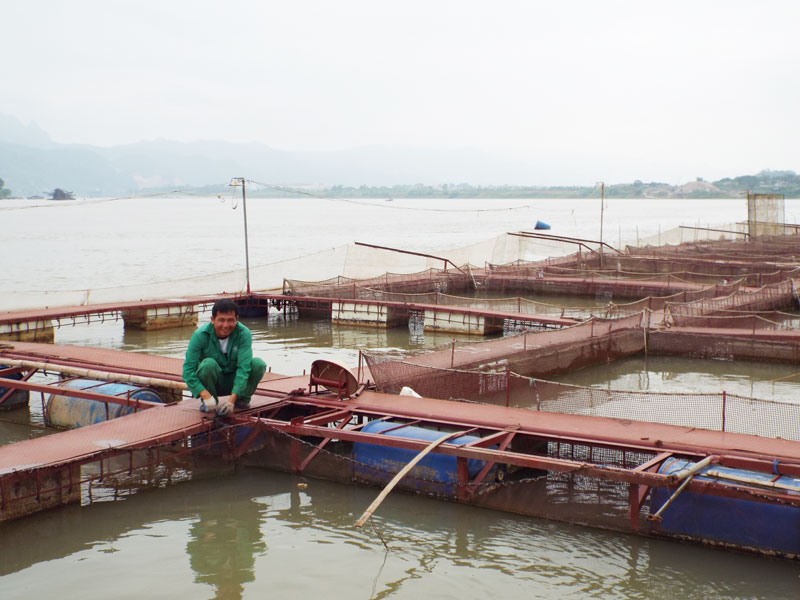
(HBO) - In the current situation of aquatic resources in Da river basin, Hoa Binh lake area faces the risk of decline, Ministry of Agriculture and Rural Development instructed the General Department of Fisheries to coordinate with localities to develop and implement the project of protecting and regenerating aquatic resources in Da River basin in the period of 2018-2022, to achieve the objective of sustainable development and exploitation of aquatic resources in the region.

Hoa Binh province has attracted 35
businesses, cooperatives to invest in breeding fish in Da river area.
Song Da is the largest tributary of the Red
River system, flowing through the provinces of Lai Chau, Dien Bien, Son La, Hoa
Binh, Phu Tho and Ha Noi with a great aquatic resources. According to the
research, the fish fauna of the Da river basin has 19 different species of high
economic value, 8 species of rare fish in the Vietnamese Red Book and 3 clans
have characteristics for mountainous areas and Northern plateau. The establishment
of the artificial reservoir system together with the increase in the intensity
of exploitation and development of aquaculture without controll causes
seriously impact on the plan to protect fisheries resources in the near future.
The number of boats have increased rapidly. In Hoa Binh province, there were
only 950 units in 2008, but now, this number has increased to 1,475 units,
1,139 net plates, nearly 500 lighters, and 3 layers of 1,200 sheets. Meanwhile,
Son La province has 520 motor boats with a capacity of 4,695 cv, 2,535 manual
boats operating on rivers and lakes and 14,250 fishing vehicles.
According to Mr. Hoang Van Son, the
head of the Fisheries Department, Hoa Binh said: Hoa Binh Lake has a water
surface area of 8,892 hectares in 19 communes near the lake. Aquaculture is
bringing opportunities for hunger elimination, poverty reduction and enrichment
for people and businesses. The province has about 4,050 cages for fish raising,
equivalent to 220 thousand m3, the total output reached 7,700 tons, creating
jobs and stable income for over 5,000 workers. When the project is implemented,
it will contribute the human resources to the province for carrying out
activities to support, propagate and improve the capacity of State management
when implementing the Law on Fisheries and relevant documents to achieve higher
efficiency, contributing to sustainable development of aquaculture.
According to data from the Hoa Binh Provincial Party Committee, the industrial production index for the first six months of 2025 is estimated to have increased by 20% compared to the same period last year. This marks the highest year-on-year growth rate for this period since 2020.
In the first six months of 2025, Hoa Binh province’s export turnover was estimated at 1.145 billion USD, marking an 18.11% increase compared to the same period in 2024. Import turnover was estimated at $ 804 million, a 17.15% increase, which helped the province maintain a positive trade balance.
The lives of the ethnic minority farmers in Tan Lac district have gradually improved thanks to the new directions in agricultural production. This is a testament to the collective strength fostered through the professional associations and groups implemented by various levels of the district’s Farmers’ Union.
With the motto the "product quality comes first,” after nearly one year of establishment and operation, Muong village’s Clean Food Agricultural and Commercial Cooperative, located in Cau Hamlet, Hung Son Commune (Kim Boi district), has launched reputable, high-quality agricultural products to the market that are well-received by consumers. The products such as Muong village’s pork sausage, salt-cured chicken, and salt-cured pork hocks have gradually carved out a place in the market and they are on the path to obtaining the OCOP certification.
In the past, the phrase "bumper harvest, rock-bottom prices" was a familiar refrain for Vietnamese farmers engaged in fragmented, small-scale agriculture. But today, a new spirit is emerging across rural areas of Hoa Binh province - one of collaboration, organisation, and collective economic models that provide a stable foundation for production.
Maintaining growing area codes and packing facility codes in accordance with regulations is a mandatory requirement for agricultural products to be eligible for export. Recently, the Department of Agriculture and Environment of Hoa Binh province has intensified technical supervision of designated farming areas and packing facilities to safeguard the "green passport" that enables its products to access international markets.



